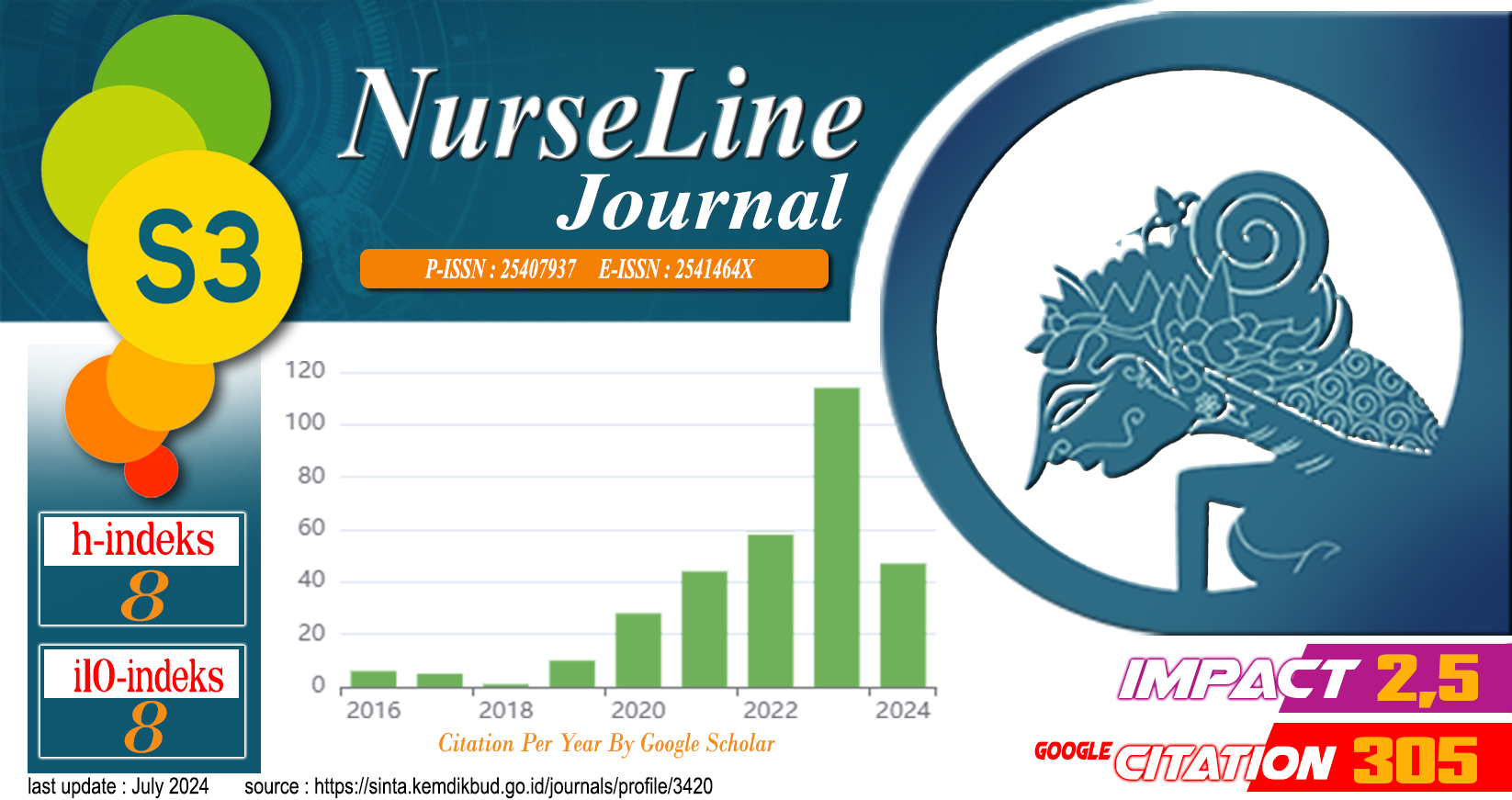Community Self-Efficacy of Coronary Heart Disease Based on Characteristic Risk Factors
Abstract
Coronary heart disease is one of the main causes of mortality rate in the world. This disease is affected by several risk factors. People who have high or moderate risk factors for coronary heart disease should have good preventive behavior, but this also requires a good level of self-efficacy as well, so that the expected behavior can be performed. This study aimed to determine the level of community self-efficacy of coronary heart disease based on characteristic risk factors. This research used a descriptive quantitative approach. Participant consisted of 70 people in Desa Limusgede, West Java, Indonesia acquired through a non-probability technique of purposive sampling. Self-efficacy was measured using a self-efficacy questionnaire (validity value in the range of 0.484 to 0.773 and reliability value 0.862) while risk factor data were determined by age, body mass index, blood pressure, smoking behavior, diabetes mellitus, and physical activity which were referenced by Jakarta Cardiovascular Score. Data were analyzed using median and frequency distribution. The results showed that median (minimum-maximum score) of self-efficacy is 26.00 (11-41), most of the respondent (62.86%) had high self-efficacy of coronary heart disease and more than a half respondent (47.14%) had moderate and high-risk factors for cardiovascular disease. Further, almost half the respondent who had high self-efficacy also had moderate and high-risk factors for cardiovascular disease. So, the health professional must concern in activities to decrease the level of cardiovascular risk factors, such as health education, health promotion, and disease prevention.
References
Anggai, A.I. 2015. Hubungan Antara Efikasi Diri dengan Perilaku Berisiko terhadap Kesehatan pada Remaja. Skripsi. Universitas Muhammadiyah Surakarta.
Bauters, C., Lamblin, N., Fadden, E., Eric van Belle, Millare, A., & Pasca de Groote. 2003. Influence of Diabetes Mellitus on Heart Failure Risk and Outcome. Cardiovascular Diabetology, Centre Hospitalier Universitaire de Litle, 1-3.
Clark, N.M. & Dodge, J.A. 1999. Exploring Self-Efficacy as a Predictor of Disease Management. Health Education & Behaviour, 26(1):72-89.
Galbut, B.H. & Davidson, M.H. 2005. Cardiovascular Disease: Practical Applications of the NCEP ATP III Update. Patient Care, March, 31-38.
Holloway & Watson. 2002. Role of Self-Efficacy and Behaviour Change [Abstract]. International Journal of Nursing Practice, 8(2):106-115. Abstract retrieved from http://europepmc.org/abstract/med/11993577.
Indonesian Ministry of Health. 2011. Guidelines for controlling risk factors for heart disease and blood vessels(1st ed.). Jakarta, Indonesia: Kementerian Kesehatan Republik Indonesia. Retrieved from http://www.pptm.depkes.go.id/cms/frontend/ebook/Pedoman_PJPD_2013.pdf.
Indonesian Ministry of Health. 2013. Riset Kesehatan Dasar: Riskesdas 2013. Jakarta: Badan Penelitian dan Pengembangan Kesehatan. Retrieved from http://www.depkes.go.id/resources.download/general/Hasil%20Riskesdas%202013.pdf.
Islamee, A.U. 2008. Faktor-Faktor Risiko Kardiovaskular yang Berhubungan dengan Ada atau Tidak Adanya Kelainan pada Hasil Elektrokardiografi pada Jamaah Majelis Dzikiri SBY Nurussalam Tahun 2008. Mini Thesis. Universitas Indonesia.
Kim, Y. 2011. Adolescent’s Health Behaviors and Its Associations with Psychological Variables. Journal of Public Health, 19: 205-209.
Kusmana, D. 2002. The Influence of Smoking Cessation, Regular Physical Exercise and/or Physical Activity on Survival: A 13 years’ Cohort Study of the Indonesian population in Jakarta. Medical Journal of Indonesia, 11(4), 230–241.
Lipoeta, I. 2006. Gizi dan Makanan pada Penyakit Kardiovaskular. Yogyakarta: Andalah Insist Press.
Liu, J., Sempos, C., & Donahue, R.P. 2005. Joint Distribution of Non-HDL and LDL Cholesterol and Coronary Heart Disease Risk Prediction among Individuals with and without Diabetes. Diabetes Care, 28: 1916-1921.
Mawi, M. 2003. Indeks Massa Tubuh sebagai Determinan Penyakit Jantung Koroner pada Orang Dewasa Berusia diatas 35 Tahun. Jurnal Kedokteran Trisakti, 23 (3): 87-92.
Meland, E., Maeland, J.G., & Laerum, E. 1999. The Importance of Self-Efficacy in Cardiovascular Risk Factor Change [Abstract]. Scand J Public Health, 27(1):11-7. Abstract retrieved from https://www.ncbi.nlm.nih.gov/pubmed/10847665.
Nababan, D. 2008. Hubungan Faktor Risiko dan Karakteristik Penderita dengan Kejadian Penyakit Jantung Koroner di RSU Dr. Pirngadi Medan Tahun 2008. Thesis. Universitas Sumatera Utara.
Ormrod, J.E. 2008. Psikologi Pendidikan. Jakarta: Penerbit Erlangga.
Ragin, D.F. 2011. Health Psychology an Interdisciplinary Approach to Health. Boston: Pearson.
Rahmadian, S. 2011. Faktor-Faktor Psikologis yang Mempengaruhi Perilaku Sehat Mahasiswa Beberapa Perguruan Tinggi di Tangerang Selatan. Skripsi. Universitas Islam Negeri Syarif Hidayatullah.
Smeltzer, S.C.O., Bare, B.G., Hinkle, J.L. & Cheever, K.H. 2010. Brunner and Suddarth’s Textbook of Medical-Surgical Nursing (12th ed.). Philadelphia, PA: Wolters Kluwer Health.
Sol, B.G.M., Graaf, Y.D.V., Bijl, J.V.D., Goessens, N.B.G., & Visseren, F.L.J. 2006. Self-Efficacy in Patients with Clinical Manifestations of Vascular Diseases [Abstract]. Patient Education & Counceling, 61(3):443-448. Abstract retrieved from https://www.pec-journal.com/article/S0738-3991(05)00155-2/abstract.
Supriyono, M. 2008. Faktor-Faktor Risiko yang Berpengaruh terhadap Kejadian Penyakit Jantung Koroner pada Kelompok Usia ≤ 45 tahun, Studi Kasus di RSUP Dr. Kariadi dan RS Telogorojo Semarang. Thesis. Universitas Diponegoro.
World Health Organization. 2016. World Health Statistic 2016: Monitoring Health for the SDGs, Sustainable Development Goals. WHO Press p60. Retrieved from http://www.who.int.iris/bitstream/10665/44844/1/9 7892141564441_eng.pdf.
Yanti, Supriyono, & Tony. 2008. Faktor-Faktor Risiko Kejadian Penyakit Jantung Koroner pada Penderita Diabetes Mellitus Tipe 2, Studi Kasus di RSUP Dr. Kariadi Semarang. Retrieved from http://eprints.undip.ac.id/6495/1/Yanti.pdf.

This work is licensed under a Creative Commons Attribution-ShareAlike 4.0 International License.
















